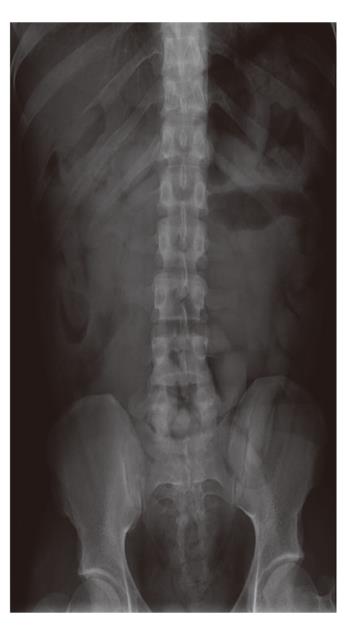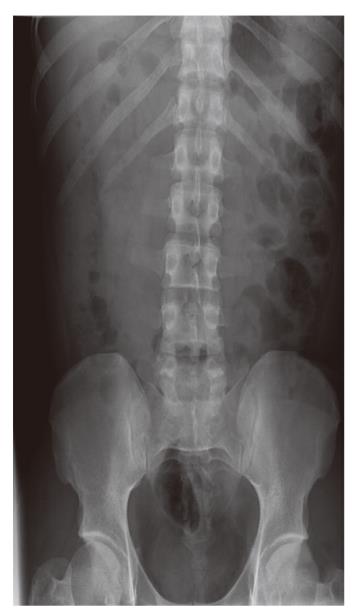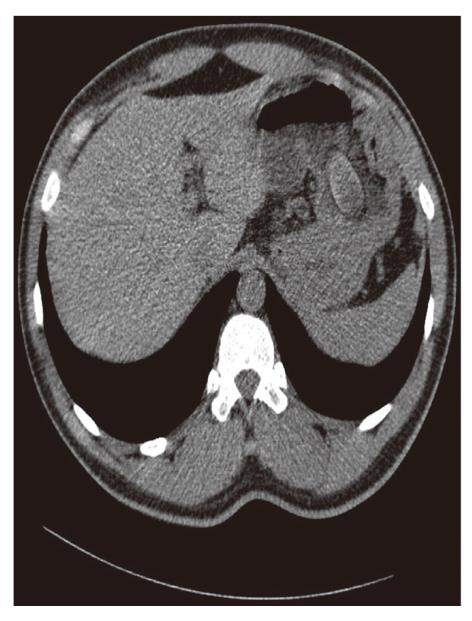Published online Jun 28, 2011. doi: 10.4329/wjr.v3.i6.155
Revised: March 2, 2011
Accepted: March 9, 2011
Published online: June 28, 2011
Management of patients carrying packets of drugs in the digestive tract is a frequent medical problem. We report on a patient who was referred by the police after ingestion of packets of cocaine. After spontaneous elimination of 81 drug packets, the patient had three unremarkable stools. A plain abdominal X-ray disclosed no residual packet but computed tomography (CT) scan showed one in the stomach. As this was not eliminated during the 10 d following ingestion, it was removed through gastrotomy. This case stresses the usefulness of the CT scan to ensure that no residual packet is present before hospital discharge.
- Citation: Beauverd Y, Poletti PA, Wolff H, Ris F, Dumonceau JM, Elger BS. A body-packer with a cocaine bag stuck in the stomach. World J Radiol 2011; 3(6): 155-158
- URL: https://www.wjgnet.com/1949-8470/full/v3/i6/155.htm
- DOI: https://dx.doi.org/10.4329/wjr.v3.i6.155
Management of patients carrying packets of drugs is a recurrent medical problem. Usually, patients have no complications and current recommendations for such patients advise a conservative approach, waiting for a spontaneous packet’s evacuation with the bowel movement. In case of complications such a packet stuck in the stomach, a surgical approach seems to be safer than an endoscopic approach.
Usually plain abdominal X-ray (AXR) is the radiological examination used to detect packets in body-packers and to confirm that all packages have been removed. However, this exam can sometimes miss a packet and bear the risk of missing a diagnosis especially if the packet is stuck and not spontaneously expulsed. Computed tomography (CT) scan is more sensitive than plain abdominal radiography to detect residual packets but is also more expensive, time consuming and delivers more radiation.
A 34-year-old man was referred by the police to the emergency room of our hospital for suspicion of drug body packing. The patient admitted having swallowed 82 plastic-wrapped cocaine packets. At admission, he was asymptomatic, his medical history was uneventful, and vital signs and physical exam were normal. Our “body pack” protocol consists, in asymptomatic patients, of starting with plain AXR to detect packets. In unclear cases, additional abdominal CT scan is done. Neither blood tests nor urine drug screening are carried out routinely because they are not of any diagnostic value. Management consists of a conservative approach, waiting for patients to evacuate packets, without use of any laxatives[1,2] because this use might increase complications by inducing a rupture or small lesions of the packages. After having passed three stools without packets we carry out a control X-ray exam which consists of AXR. CT scan is useful for control if there is a discrepancy between results of AXR and the numbers of packets expected to be collected. For detection, current protocols use AXR or CT scan if needed[3-5]. Some propose to screen drugs[4], but there is no consensus with this approach[5]. For management, some authors use laxatives[4,5]. In line with our protocol, in this asymptomatic patient neither blood tests nor urine drug screens were carried out. An AXR showed multiple X-ray dense oval packets in the abdomen compatible with body packing (Figure 1). The patient was kept under surveillance and he uneventfully excreted 81 packets (multi-layered machine-made plastic containers) within 4 d. A rapid test confirmed that these packets contained cocaine. After having passed three stools without packets, the patient had two control X-ray exams: an AXR (Figure 2) and an abdominal CT scan (Figure 3), in accordance with our management protocol. CT scan was performed without oral or intravenous contrast media, using a sixteen multi-row Philips MX 8000 scanner (Philips Medical Systems, Best, The Netherlands), with a reconstruction slice thickness of 5.0 mm, pitch of 1.25, and 0.5-s gantry rotation period. The X-ray tube potential was 120 kV, with a tube charge per gantry rotation of 30 mA. The scanned length was 40 cm. The CT disclosed a single packet localised inside the stomach that was not visible on the AXR. The patient remained asymptomatic and a proton pump inhibitor (esomeprazole 40 mg po qd) was administered to reduce the risk of degradation of the bag because of the acidity of the stomach. The CT scan was repeated 3 d later, which again disclosed the container in the stomach. The promotility drug metoclopramide (10 mg po tid) was administered to accelerate transpyloric passage of the packet[3]. The cocaine container had not been eliminated after three additional days. A third abdominal CT scan was carried out which concluded that the cocaine packet was still in the stomach. As more than 10 d had elapsed since packet ingestion, the likelihood of spontaneous elimination was estimated to be low and the packet was extracted through surgical gastrotomy after a small median laparotomy. No complication ensued and the patient was transferred to jail 10 d after surgery.
Our protocol concerning the management of body-packers has been used during the past 30 years and consists of a conservative approach: we wait for patients to evacuate packets by normal bowel movements, without use of any laxatives. In 2009, 29 body packers were treated at the prison hospital ward. According to current recommendations[1,2], no treatment other than surgery was administered to the patient. Laxatives were not prescribed to accelerate packets’ elimination because the most frequently used laxative, paraffin oil, may favor packet rupture and drug intoxication (mineral oil causes a decrease in strength and flexibility of latex within 15 min)[6,7]. However, we acknowledge that the risk of rupture is much lower with modern, multilayered (type 4), packets similar to those found in this patient[8], and that paraffin oil has been systematically administered in a series of 573 body-packers with a low (1%) rupture rate[9].
Endoscopic extraction was not attempted as endoscopic manipulation of such packets may result in rupture and the cocaine content of a single packet exceeds the lethal dose. To our knowledge, only three cases of successful endoscopic extraction of cocaine packets from the upper digestive tract have been reported, all of these in patients who had refused surgery[10-12]. Our patient provided informed consent prior to surgery.
Usually, AXR is used to detect body-packers. In our case, CT scan disclosed a remaining packet in the stomach that was undetected at AXR. The sensitivity of AXR for packet detection is approximately 85%-90%[13]. There is evidence that an abdominal CT scan is better than AXR to detect residual packets[14]. Management to identify residual body-packers should balance the diagnostic superiority of abdominal CT scan, the risks of medical complications if containers are not detected with AXR, but also the higher radiation delivery and cost of abdominal CT scan. There isn’t much literature about methods to detect drug packets avoiding exposure to radiation such as ultrasound[15,16] and magnetic resonance imaging[17]. Current protocols recommend the use of AXR to confirm packet retention and, in case of doubt, the use of abdominal CT scan with reduced mAs, delivering a dose of radiation close to that of an AXR[4,18]. Therefore, it is our practice to perform an AXR after elimination of three packet-free stools, followed by a CT scan in cases where suspicion of retained packets is high despite a negative AXR.
In conclusion, according to our experience, management of asymptomatic body-packers should first be conservative. In case of complications, such as packet rupture or intestinal obstruction, surgery - and not endoscopy - is the method to use. Although newer package types used for concealment of drugs inside the abdomen are more resistant, we think that surgical extraction remains the safest extraction procedure in cases of retention.
Peer reviewer: Dr. Charikleia triantopoulou, Konstantopouleion Hospital, Agias Olgas street, Athens, 14233 N. Ionia, 3-5, Greece
S- Editor Cheng JX L- Editor O’Neill M E- Editor Zheng XM
| 1. | Eisen GM, Baron TH, Dominitz JA, Faigel DO, Goldstein JL, Johanson JF, Mallery JS, Raddawi HM, Vargo JJ, Waring JP. Guideline for the management of ingested foreign bodies. Gastrointest Endosc. 2002;55:802-806. [RCA] [PubMed] [DOI] [Full Text] [Cited by in Crossref: 399] [Cited by in RCA: 360] [Article Influence: 15.7] [Reference Citation Analysis (0)] |
| 2. | Webb WA. Management of foreign bodies of the upper gastrointestinal tract: update. Gastrointest Endosc. 1995;41:39-51. [RCA] [PubMed] [DOI] [Full Text] [Cited by in Crossref: 390] [Cited by in RCA: 356] [Article Influence: 11.9] [Reference Citation Analysis (0)] |
| 3. | Traub SJ, Su M, Hoffman RS, Nelson LS. Use of pharmaceutical promotility agents in the treatment of body packers. Am J Emerg Med. 2003;21:511-512. [RCA] [PubMed] [DOI] [Full Text] [Cited by in Crossref: 8] [Cited by in RCA: 9] [Article Influence: 0.4] [Reference Citation Analysis (0)] |
| 4. | Mandava N, Chang RS, Wang JH, Bertocchi M, Yrad J, Allamaneni S, Aboian E, Lall MH, Mariano R, Richards N. Establishment of a definitive protocol for the diagnosis and management of body packers (drug mules). Emerg Med J. 2011;28:98-101. [PubMed] |
| 5. | Beckley I, Ansari NA, Khwaja HA, Mohsen Y. Clinical management of cocaine body packers: the Hillingdon experience. Can J Surg. 2009;52:417-421. [PubMed] |
| 6. | Visser L, Stricker B, Hoogendoorn M, Vinks A. Do not give paraffin to packers. Lancet. 1998;352:1352. [RCA] [PubMed] [DOI] [Full Text] [Cited by in Crossref: 19] [Cited by in RCA: 17] [Article Influence: 0.6] [Reference Citation Analysis (0)] |
| 7. | White N, Taylor K, Lyszkowski A, Tullett J, Morris C. Dangers of lubricants used with condoms. Nature. 1988;335:19. [RCA] [PubMed] [DOI] [Full Text] [Cited by in Crossref: 28] [Cited by in RCA: 26] [Article Influence: 0.7] [Reference Citation Analysis (0)] |
| 8. | Pidoto RR, Agliata AM, Bertolini R, Mainini A, Rossi G, Giani G. A new method of packaging cocaine for international traffic and implications for the management of cocaine body packers. J Emerg Med. 2002;23:149-153. [RCA] [PubMed] [DOI] [Full Text] [Cited by in Crossref: 60] [Cited by in RCA: 50] [Article Influence: 2.2] [Reference Citation Analysis (0)] |
| 9. | de Prost N, Lefebvre A, Questel F, Roche N, Pourriat JL, Huchon G, Rabbat A. Prognosis of cocaine body-packers. Intensive Care Med. 2005;31:955-958. [RCA] [PubMed] [DOI] [Full Text] [Cited by in Crossref: 34] [Cited by in RCA: 28] [Article Influence: 1.4] [Reference Citation Analysis (0)] |
| 10. | Macedo G, Ribeiro T. Esophageal obstruction and endoscopic removal of a cocaine packet. Am J Gastroenterol. 2001;96:1656-1657. [RCA] [PubMed] [DOI] [Full Text] [Cited by in Crossref: 10] [Cited by in RCA: 14] [Article Influence: 0.6] [Reference Citation Analysis (0)] |
| 11. | Sherman A, Zingler BM. Successful endoscopic retrieval of a cocaine packet from the stomach. Gastrointest Endosc. 1990;36:152-154. [RCA] [PubMed] [DOI] [Full Text] [Cited by in Crossref: 8] [Cited by in RCA: 10] [Article Influence: 0.3] [Reference Citation Analysis (0)] |
| 12. | Choudhary AM, Taubin H, Gupta T, Roberts I. Endoscopic removal of a cocaine packet from the stomach. J Clin Gastroenterol. 1998;27:155-156. [RCA] [PubMed] [DOI] [Full Text] [Cited by in Crossref: 13] [Cited by in RCA: 15] [Article Influence: 0.6] [Reference Citation Analysis (0)] |
| 13. | Traub SJ, Hoffman RS, Nelson LS. Body packing--the internal concealment of illicit drugs. N Engl J Med. 2003;349:2519-2526. [RCA] [PubMed] [DOI] [Full Text] [Cited by in Crossref: 232] [Cited by in RCA: 193] [Article Influence: 8.8] [Reference Citation Analysis (0)] |
| 14. | Yang RM, Li L, Feng J, Lai SS, Lin BQ, Yu T, Ye XH, Xu YK. Heroin body packing: clearly discerning drug packets using CT. South Med J. 2009;102:470-475. [RCA] [PubMed] [DOI] [Full Text] [Cited by in Crossref: 33] [Cited by in RCA: 33] [Article Influence: 2.1] [Reference Citation Analysis (0)] |
| 15. | Meijer R, Bots ML. Detection of intestinal drug containers by ultrasound scanning: an airport screening tool? Eur Radiol. 2003;13:1312-1315. [PubMed] |
| 16. | Hierholzer J, Cordes M, Tantow H, Keske U, Mäurer J, Felix R. Drug smuggling by ingested cocaine-filled packages: conventional x-ray and ultrasound. Abdom Imaging. 1995;20:333-338. [RCA] [PubMed] [DOI] [Full Text] [Cited by in Crossref: 58] [Cited by in RCA: 50] [Article Influence: 1.7] [Reference Citation Analysis (0)] |
| 17. | Wackerle B, Rupp N, von Clarmann M, Kahn T, Heller H, Feuerbach S. [Detection of narcotic-containing packages in "body-packers" using imaging procedures. Studies in vitro and in vivo]. Rofo. 1986;145:274-277. [PubMed] |
| 18. | Poletti PA, Platon A, Rutschmann OT, Verdun FR, Schmidlin FR, Iselin CE, Vermeulen B, Sarasin FP, Buhler LH, Becker CD. Abdominal plain film in patients admitted with clinical suspicion of renal colic: should it be replaced by low-dose computed tomography? Urology. 2006;67:64-68. [RCA] [PubMed] [DOI] [Full Text] [Cited by in Crossref: 15] [Cited by in RCA: 11] [Article Influence: 0.6] [Reference Citation Analysis (0)] |











